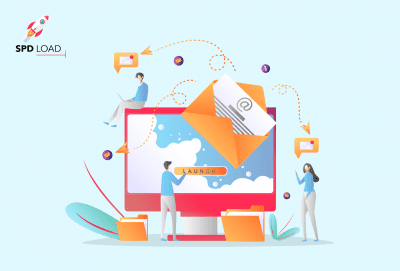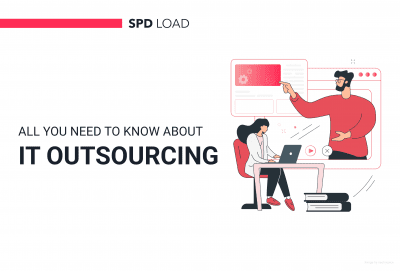Education App Development: Ultimate Guide for 2025
- Updated: Nov 14, 2024
- 12 min
The education app market is booming and is expected to grow at 14% CAGR between 2025 and 2032.
Digital learning is growing fast, creating opportunities for innovative EdTech solutions.
But building an education app can be daunting. You must consider costs, timing, key features, technical partners, and go-to-market plans.
In this comprehensive guide, we cover everything you need to successfully develop and launch the next hit education app, including:
- Key education app market statistics and growth trends to inform your opportunity analysis
- A realistic breakdown of budgeting for an EdTech build
- A step-by-step framework for designing and developing your app concept
- Checklist for vetting and picking the right development team
- Overview of our build, launch, and scale process for taking your idea from concept to real-world impact
Ready to enter the education tech field? Feel free to discover EdTech startup ideas that can change how people learn and grow.
Let’s get started on making your EdTech vision a reality!
For first-time founders, these business startup tips can make all the difference.
Unlock your startup potential now — start transforming your vision into a scalable solution today!
Why Create an EdTech Startup Now?
As we all know, the Covid-19 pandemic and the consequential restrictive laws changed the way people interact, work, and learn.
It’s about efficiency and proper time management.
Education is moving toward flexibility and applicability
The outcome of this opens opportunities for educational app development to develop new EdTech startups and bring new business models and innovation.
Therefore, future founders should create innovative apps that appeal to students, tutors, and educational institutions.
Some online educational solutions that entrepreneurs should consider due to the surge in demand include:
- Learning applications for easing the learning process of toddlers.
- Students, applicants, and pupils that need help to prepare for exams (For example, book summary apps). Apart from that, AI writing tools are being used to create effective CTAs and email subject lines.
- Specialists willing to get a new qualification,
- Individuals with the desire to try something different, upgrade their educational qualifications and master a skill.
To help you make an educated decision on the type of app you’d like to opt for, we’ll discuss the cost involved in subsequent sections but first, let us discuss the market landscape.
E-Learning Industry Growth Statistics
- Suggests that the eLearning market was valued at $399.3 billion in 2022 and is anticipated to grow at 14% CAGR between 2023 and 2032
- Another report indicates that the market will grow by $46.88 billion during 2020-2025.
The online learning market is well on course to bring this prediction to reality as investments in this sector peaked in 2020.
Most of that money, 42.9%, which are going into EdTech are based in the US.
Of all those investments, a significant part of that money went to AI-based learning tools, e.g., virtual reality, while mobile learning tools account for 15.9% of the investment. 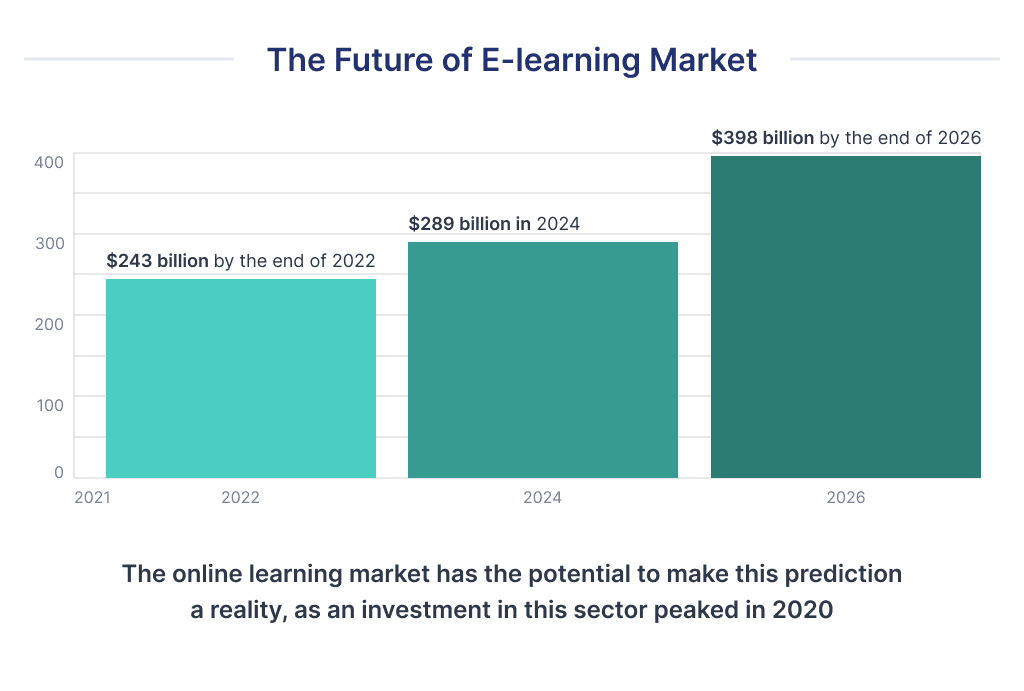
Ideal Timing for Mobile App Development
During the first half of 2019 and up to now, the Covid-19 pandemic caused a surge in traffic going to online educational platforms and learning materials.
According to statistics, in 2022 Duolingo was the most popular learning and education app in the world, with 98 million downloads.
Educational apps currently rank the third most popular application category on Apple Store and the second most downloaded category on the Google Play Store.
The primary reason for the increase is the impact of the Covid-19 pandemic that has shifted from the traditional teaching method. It shows that people are gradually beginning to embrace the idea of learning with apps.
From teaching how to make custom oil paintings from photos, to different programming languages, professionals are also interested in this type of education including those pursuing an Associate degree in business.
More and more tech companies recognize this demand surge and are filling the gap by venturing into e-learning app development services for the education industry.
For example, TikTok launched #LearnOnTikTok in 2020, a platform that helps TikTok users self educate in a fun but highly educative way.
As they say, use gamification correctly, and it will become a viral trend.
TikTok changed the game — now it’s your turn. Learn how to make a TikTok-like app with all the right features. 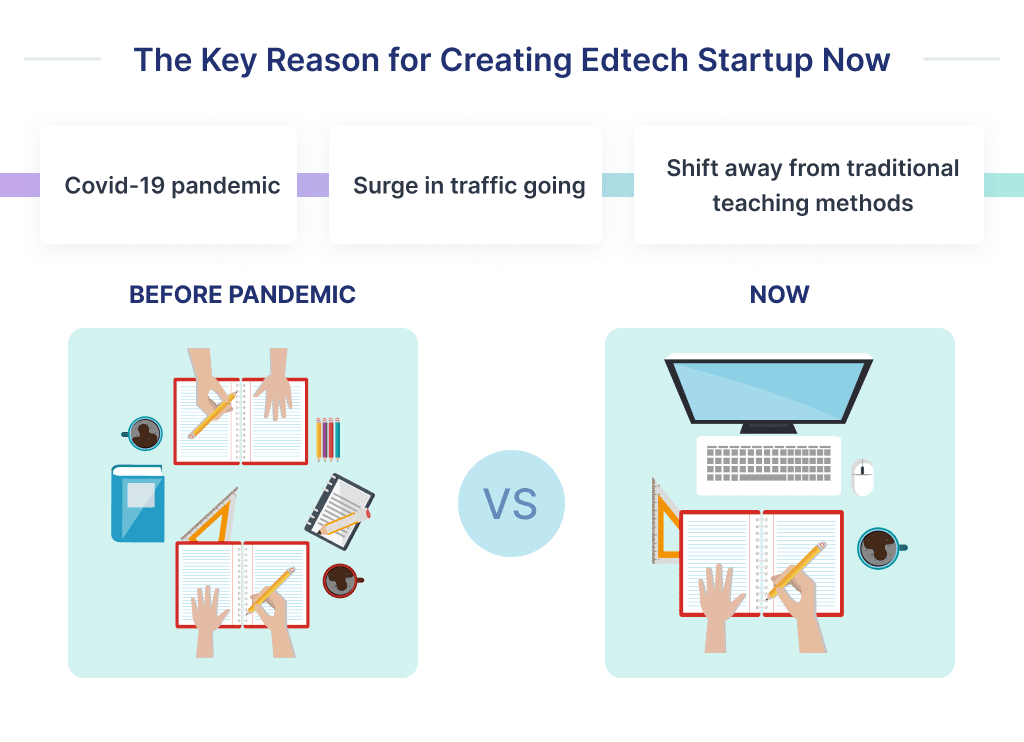
What’s the Cost of Developing an Education App?
The cost of the development of an MVP of educational app varies from $30,000 to $50,000.
It is the price of software MVP development.
The price depends on various factors: from the complexity of an idea to the level and location of an app development company.
Picking the right partner is crucial — here’s how to choose an app development company that fits your needs.
Let’s take a closer look at a few factors.
1. Concept Complexity
The complexity of the application’s concept directly impacts the development costs.
How?
The difficulty of business logic like the number of roles, number of features, number of integrations, the kind of monetization or in-app purchases defines the complexity of the product.
The complex concept also means more advanced design, more research, and more planning.
And finally, complex business applications usually require more infrastructure work. For example, integration of additional security protocols or creating autoscaling via Kubernetes.
Here are a couple of examples, so you know what kind of numbers we’re talking about.
| Complexity | Cost |
| Simple education app | $30,000+ |
| Middle education app | $50,000+ |
| Complex education app | $75,000+ |
2. Development Team Type
As you can deduce from the table below, the cost of an educational application varies significantly with your developmental team.
If you’re giving the contract to US-based educational mobile app developers, then you’ll be spending way more than providing the same contract to a team based in Ukraine.
Get a clear picture of the cost of hiring a software developer to budget for your next project.
| Team location | Rate per hour | MVP (3+ months) | Scaled MVP (6+ months) |
| The USA | $150 | $200,000 | $400,000 |
| Ukraine | $40 | $40,000 | $80,000 |
| India | $20 | $25,000 | $50,000 |
Ready to test your startup idea? Learn everything about how to launch an MVP successfully.
3. Application Type
In estimating the cost of developing an educational app, you should consider the type of product you’re building.
For example, developing an educational app for a single platform will be cheaper than those designed for multiple platforms.
Similarly, EdTech products for wearables ( e.g., augmented reality) and connected TVs will significantly raise your mobile app’s cost.
Augmented reality is reshaping industries. Check out the latest AR statistics to see its impact.
| Type | Cost | Example |
| Language learning app | $45,000 | Duolingo |
| Math learning app | $55,000 | Rocket Math |
| Mobile learning management system | $70,000 | TalentLMS |
| App for organizing the learning process | $65,000 | Formative |
4. Platform Type
Another sub-factor to consider is an operating system. There are native apps developed especially for one type of OS.
And hybrid apps that fit both iOS and Android. Also, hybrid apps are a priori cheaper, as you pay once for double effort.
If you’re planning to build an app, these detailed guides on Android app development costs and iOS app development costs will help you navigate the financial aspects.
| Platform | Cost |
| Native app on iOS | $60,000 |
| Native app on Androind | $55,000 |
| Hybrid app for iOs and Android | $40,000 |
Hidden Development Costs
The hidden costs of app development include maintenance and marketing. Without neither of these, you cannot create an e-learning startup that people will like.
Maintaining your app includes upgrading its features and functionalities, fixing important bugs, scale servers, and many more.
Based on how much does it cost to build an MVP, the maintenance of an EdTech product will cost $4,000 – $8,000 annually. It is 15-20% of the initial development budget.
Apart from maintaining your application, you should also market it to ensure that it reaches your target market.
Marketing a new educational app for online learning will cost you 2-3 times as much as developing it. Let’s take the MVP price as a basis. Marketing will cost $75,000 – $150,000 per year.
Looking for effective tools? Here are some top email marketing software platforms to consider for your business.
We have considered the main factors that form the budget for product development including, hidden costs. Now let’s take a closer look at the development process. 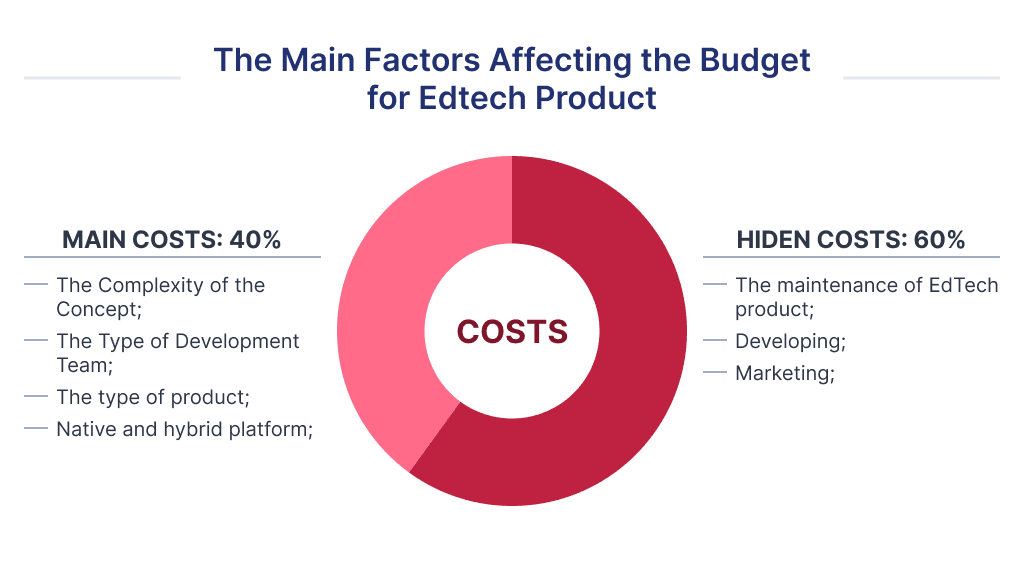
How to Create an Educational App
Before building an online educational learning solution, you must plan your actions.
Do this by having adequate knowledge of the business development and technical development phase of the solution.
And here is what we have to say on this matter.
Business Planning Phase
The initial stage of the development process is the discovery stage. What is that?
It is a stage designed to apply the founder’s vision to market conditions.
It will allow initial testing of business hypotheses and selection of the most viable ones.
The project development team analyzes and collects information needed to build an EdTech app in a project discovery phase.
The team then uses gathered information to check whether a project is usable, feasible, and viable.
A breakdown of the steps involved in the discovery phase includes:
1. Customer Research
Customer research is essential to identify customers’ needs, behaviors, and segments. You can either carry it out as part of your EdTech design research or market research.
Every startup should aim to research potential users and those users who utilize other products you own and are likely to try out your EdTech platform.
The type of app you want to build determines the direction and extent of your customer research.
So, it’s best to understand how your app works to give your customers a great user experience.
2. Competitor Research
Competitor research entails identifying startups with the same product and evaluating the weaknesses and strengths of both the product and the startup.
It’s best to look at the biggest competitors for comparison as they pose the most significant threat to the success of your business.
Competitor research also helps to identify industry trends you may be missing.
3. Create Your Scope and Specifications
Scope and specifications are a part of business development that involves determining and documenting a list of deliverables, functions, deadlines, tasks, and costs.
In other words, it’s the summary of what needs to achieve and a timeline to deliver the project.
4. UX/UI Design
The UI/UX design of the platform plays a crucial role in improving user experience and customer satisfaction.
A good app design should help win your target market’s confidence and make customers constantly drawn to using your solution.
5. Project Milestones and Iterations and Decomposition
As a startup that works with the fastest time-to-market, you and the EdTech app development team must agree on a swift delivery time.
However, this timeline shouldn’t be too short that it’ll affect the software development process.
An excellent way to achieve this is to agree on achievable milestones.
Milestones also help to monitor the performance of your project.
For example, a suitable milestone in an EdTech app development process is user creation and onboarding flow.
Another one is the development of the following feature’s workflow, proceeding after signing in.
Let’s say scrolling the catalog of learning materials or choosing a mentor.
Thus, the discovery phase is essentially a guide to actions for a dedicated development team, ensuring that you understand each other correctly and follow the same goals. 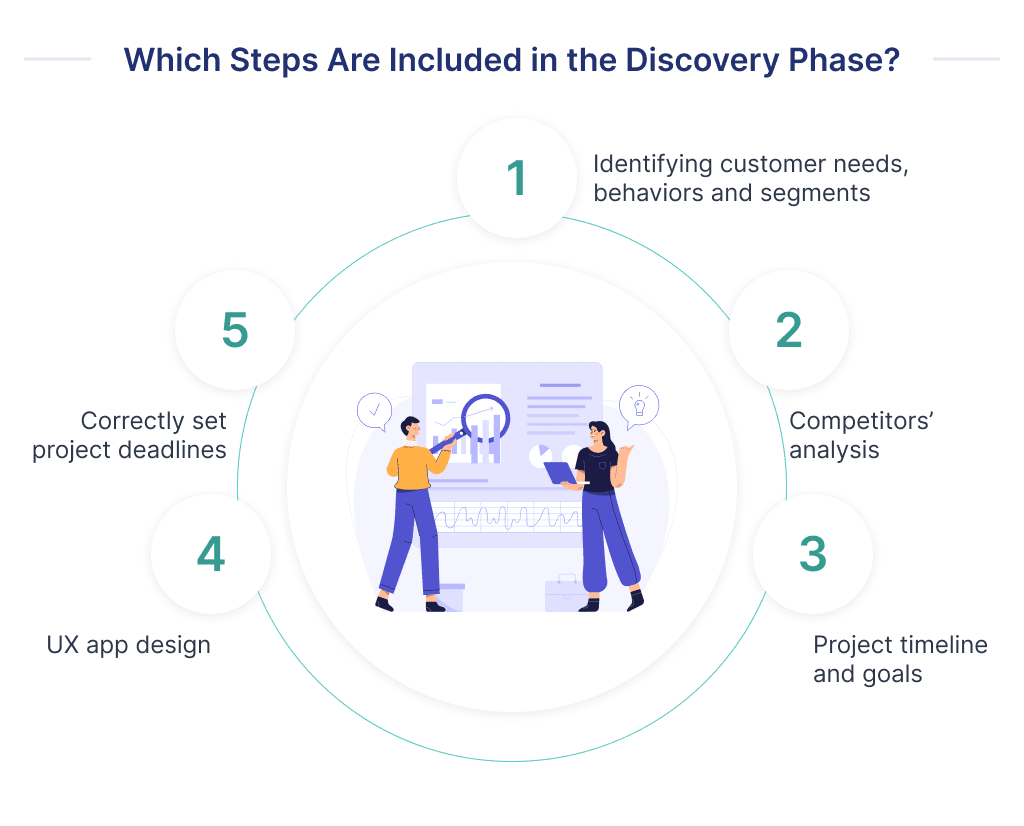
Technical Build Phase
The technical development phase involves little effort from you as a startup. The success of this critical and delicate phase depends on the hired app development team.
This team is responsible for building the app as you’ve envisioned and tailoring the features to the needs of your target audience.
The technical development phase involves launch MVP and a scaled MVP.
Crafting Custom Mobile Apps That Delight Users!
Features of an MVP
The MVP is a startup development approach that focuses on the education app’s core functionalities.
The goal of an MVP is to test the riskiest product hypothesis on the real market quickly and budget-wise.
Such a flexible approach allows rapidly pivoting a startup to find that model that works and leads to boom-like growth.
Let’s look at a real case. We created an MVP for GetCangelo, which helps users get instant help with their learning tasks. Here are the initial features we focused on:
| Feature | Description |
| Role system | GetCangelo features a role management system that helps to manage and administer user access. Role Management System groups and classifies users based on their roles and reasons for accessing the platform. |
| Management of profile | This helps teachers describe their expertise. It also allows students to know their teachers before allowing them to solve a problem. |
| Custom Chat | Chat provides users with quick answers to their queries. We designed a highly intuitive custom chat that facilitates interactive responses to user queries. |
| Matching mechanism | We created a matching tool that pairs homework assignments with the best teacher available. |
| Payment integration | This feature allows users to make payments for services received. |
| Notifications integration | The EdTech platform uses push notifications that boost user engagement. It also retains and reengages users, enhances brand consistency, and increases conversion rates. Here’s everything you need to know about building a brand from scratch, from concept to execution. |
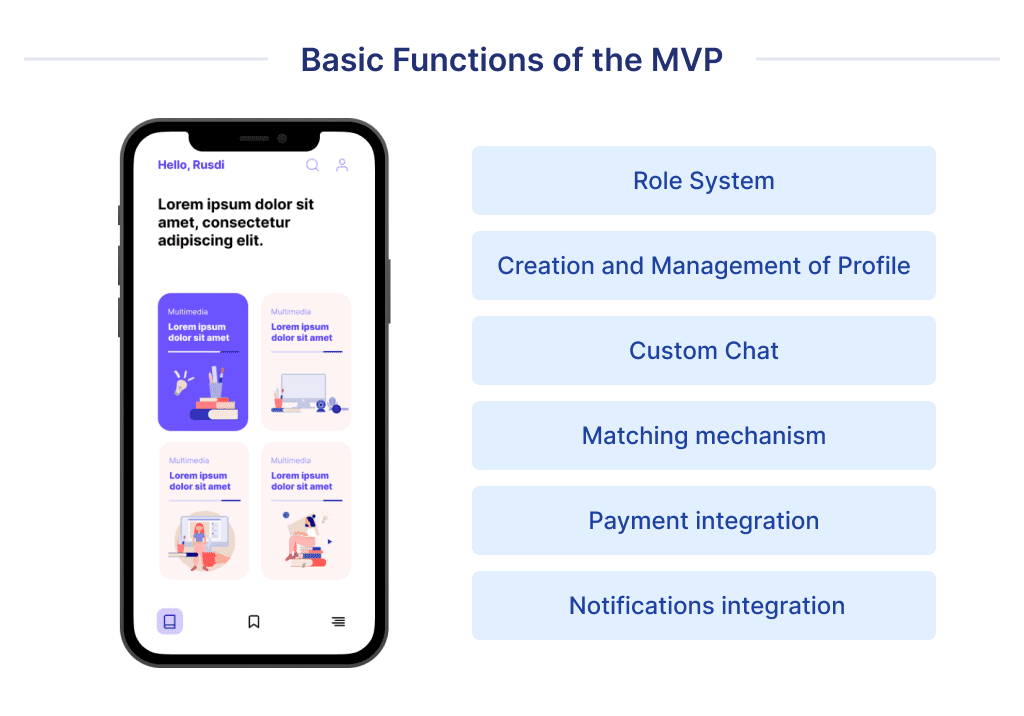
Features for a Scaled MVP
Sometimes a minimum viable product involves additional features that are not critical to the application but which will increase user engagement.
There are several cases where you should consider this option, of course, if the budget for the project allows:
- During the discovery phase, we found that user expectations are much higher than the core MVP can offer;
- These are strict requirements from the founder. But for example, our team tries to dissuade clients from increasing their budgets without a critical need;
There is a list of such sort of features:
| Feature | Description |
| Resources Catalog | The resource catalog is where the content for the e-learning platform is stored and arranged. It helps people visiting your online education platform to navigate through online courses easily, this works even if your app features an offline mode. |
| Search and Categorization | This helps users to browse or navigate through your solution. By creating grouped and understandable categories, users can separate interesting information from irrelevant. |
| Video Feedback | This is important if you want to give users the best user experience possible. Top-performing platforms like Google Classroom, Coursera provide a video feedback feature to guarantee a top-notch learning experience. |
| Learning Statistics | This will provide some basic metrics for an overview of students’ learning patterns. |

Team Composition
The composition and level of the team are the main factors that will determine the success of the development and the cost.
The composition depends on the requirements for the application. For GetCangelo, we assembled a team of 7 people:
- Project Manager
- Business Analyst
- UX/UI designer
- CTO
- Backend developer
- Mobile developer
- QA tester
Also, the composition of the team is affected by the technical stack.
For example, for native applications, you will need a separate developer for iOS and Android. While for a hybrid app, one React Native programmer will be enough.
Here’s a look at the best iOS app development tools for creating standout mobile apps.
Let’s talk about the tech stack more.
Tech Stack
The technical stack is the set of technologies used in development. The stack depends on the tasks and goals of the application.
Going back to our GetCangelo’s case study, we used the following technologies:
- Backend – Laravel
- Frontend – React Native
- 3rd party integrations – Twilio, Firebase
- Server – AWS, Redis
It’s also worth saying that the technology stack may vary depending on the team you decide to work with.
For example, our team used this stack because it is most suitable for startups that build MVPs.
And while we’re at it, let’s discuss how to choose a team. 
EdTech Development Partner Checklist
Choosing the right app development partner your education app is very important in building your EdTech solution.
The right team can benefit your company in more ways than just developing an educational app.
Let’s get started on the things to watch out for. Here are some:
| Factor to consider | Description |
| Expertise | Before choosing a learning app development team, it’s crucial that you first consider their knowledge about EdTech and the types of educational apps they have built. Having a successful product goes beyond just creating a product; you need professionals that understand your market demands. They should also know how to create a product that fits. Both are essential. |
| EdTech apps built | Beyond expertise, the number of EdTech apps your development team has built also matters. An experienced team can help you create your product faster and more efficiently. |
| Projects’ portfolio | Before you hire your team, you should check their portfolio to consider the success of their past projects. It presents evidence of your team’s abilities and skills. |
| Social media | These include checking out their Clutch, LinkedIn profile, and any other social network to verify information that supports their expertise. |
Turn Your EdTech Idea into Reality
Developing an education app that solves real learning challenges requires keen EdTech insight and dedicated development capability.
At SpdLoad, we specialize in helping committed founders turn promising EdTech ideas into successful products through our tailored app development services.
Our cross-functional team brings deep education expertise with proven methodology to design, build, test, and launch apps purpose-built to drive real impact from day one.
Let’s connect to join forces and develop the next breakthrough education app that takes on this global market.
Protecting student privacy is more than just a legal requirement, it’s about trust and responsibility. Learn what is FERPA compliance and how it helps institutions uphold these values.
From concept to creation – launch your marketplace with SPDLoad!
Bonus Infographic
Here you’ll find a summary of our in-depth guide. Learn the highlights that will help you create a personalized education app in 2025.
Outsourcing can streamline your app development. Here’s a complete guide on finding the right mobile app developers. 




